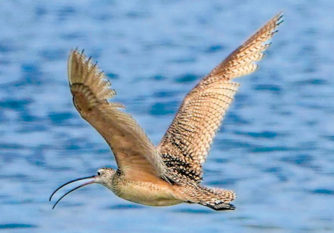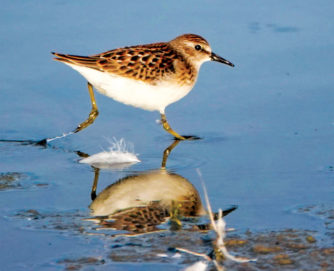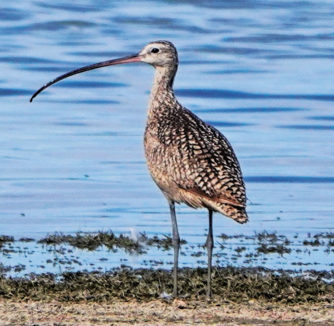Least Sandpiper

The Least Sandpiper weighs between 0.7-1.1 ounces, has a wingspan of up to 11 inches, and is 5–6 inches long.
The Least Sandpiper is the smallest shorebird in the world, and has yellow- green legs and feet. The short bill is black and slightly decurved.
Like many other sandpipers, the Least Sandpipers breed in the Arctic tundra and migrate 1,800–2,500 miles to the southern United States, Mexico, Central America, and northern South America in the winter.
They forage on mudflats and edges of shallow water, seeking food by probing and/or by sight. They feed on small crustaceans, insects, snails, and other invertebrates.
In flight, a narrow white wing-bar is seen, and the dark central feathers of the tail and the white sides are visible.
![]()
Long-billed Curlew

The Long-billed Curlew weighs from 17–34 ounces, it’s wingspan can reach 36 inches, and the bird’s length ranges from 20–26 inches.
The Long-billed Curlew is the largest shorebird on the continental United States. It has long legs and a very long, thin, curved bill. Its round head is small, the neck is long, and the body is shaped like a football.
Using its long, curved bill, it forages for earthworms in muddy substrates, and for shrimp and crabs in underground burrows and between rocks. On grassland habitats, it struts along and pecks at insects.
They breed in the grasslands of west-central North America. Known for their short to medium-distance migration, they winter along the U.S. West Coast, south into Mexico, and less often in Florida and along the southeastern Atlantic shore.
Their primitive-sounding “curlee” vocalizations are heard in flight as well.
Bird Walks Nov. 5 and Dec. 3.
Two options: 8–10:30am or 8:30–10:30am (choose a 2-hour or a 2.5-hour walk.) Both walks are free but you must RSVP at www.blufflake.org/birdwatching. All are welcome. Bring your own binoculars, or borrow a pair from your guide. 11255 MLK Blvd. Search FrontPorchNE.com for “Bird Sightings” to see all the past bird stories and photos from George Ho.This column (photos and copy) are generously donated by George Ho.






Keep sharing!!